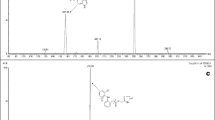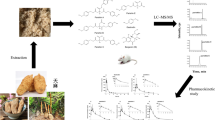Abstract
A fast, sensitive and specific liquid chromatography-mass spectrometry method has been developed for quantification of digoxin in human plasma. The method was optimized to bioequivalence studies aiming higher sensitivity and selectivity than previously published methods, in addition to shorter run time allowing high-throughput sample analyses from volunteers. Chromatographic separation was achieved by an RP-18e column hyphenated to an API 5000 mass spectrometer system set at negative electrospray ionization and operating in the MRM mode. Calibration curve was linear over a wide range of concentration (50.0–6000.0 pg mL−1), with the lower limit of quantification at 50.0 pg mL−1 and without interfering peaks at the retention time of digoxin (2.09 min). Dexamethasone was used as internal standard and samples were cleaned up by liquid-liquid extraction obtaining a mean recovery of 73.8%. Validation results confirmed inter-batch accuracy (−8.66 to 5.78%), precision (4.1–10.6%) and stability, in accordance with the U.S. Food and Drug Administration and the Brazilian National Health Surveillance Agency guidelines. The developed analytical method could be successfully applied to a single oral dose (0.25 mg), one-way, randomized, two-sequence, crossover bioequivalence study validating, up to date, the fastest analysis and the most sensitive and specific method already published for digoxin quantification.



Similar content being viewed by others
References
Silva P (2006) Farmacologia. Guanabara Koogan, Rio de Janeiro, pp 63–67, 642
Rathore S, Curtis J, Wang Y, Bristow M, Krumholz H (2003) JAMA 289:871–878. doi:10.1001/jama.289.7.871
Pähkla R, Irs A, Oselin K, Rootslane L (1999) J Clin Pharm Ther 24:375–380. doi:10.1046/j.1365-2710.1999.00239.x
Graefe KA, Tang Z, Karnes HT (2000) J Chromatogr B Anal Technol Biomed Life Sci 745:305–314. doi:10.1016/S0378-4347(00)00304-2
Belsner K, Büchele B (1996) J Chromatogr B Anal Technol Biomed Life Sci 682:95–107. doi:10.1016/0378-4347(96)00056-4
Garteiz D, Din S, Morrow R (2003) Quantification of digoxin in human plasma using negative ion electrospray ionization LC/MS. Varian Inc., Houston
Tracqui A, Kintz P, Ludes B (1997) J Cromatogr. B 692:101–109. doi:10.1016/S0378-4347(96)00462-8
Baselt RC, Cravey RH (1995) Disposition of toxic drugs and chemicals in man. Chemical Toxicology Institute, Foster City, p 802
Stone JA, Soldin SJ (1989) Clin Chem 35:1326–1331
Stoll RG, Christensen MS, Sakmar E, Wagner JG (1972) Res Commun Mol Pathol Pharmacol 4:503–510
Frommherz L, Kohler H, Brinkmann B, Lehr M, Beike J (2008) Int J Legal Med 122:109. doi:10.1007/s00414-007-0175-5
Yao M, Zhang H, Chong S, Zhu M, Morrison RA (2003) J Pharm Biomed Anal 32:1189. doi:10.1016/S0731-7085(03)00050-5
ANVISA, Agência Nacional de Vigilância Sanitária (2003) RE no 899, de 29 de Maio de 2003. Guia para validação de métodos analíticos e bioanalíticos
FDA, Center for Drug Evaluation and Research (2001) U S Department of Health and Human Services, Guidance for Industry, Bionalytical Method Validation
United States Pharmacopeia Convention (2003) United States pharmacopeia, USP 26. National Publishing, Philadelphia
Bansal S, DeStefano A (2007) AAPS J 9:E109–E114. doi:10.1208/aapsj0901011
Zöllner P, Leitner A, Lubda D, Cabrera K, Lindner W (2000) Chromatographia 52:818–820. doi:10.1007/BF02491011
Fadden KM, Gillespie J, Carney B, O’Driscoll D (2006) J Chromatogr A 1120:54–60. doi:10.1016/j.chroma.2006.01.071
Jedlička A, Grafnetterová T, Miller V (2003) J Chromatogr B Anal Technol Biomed Life Sci 33:109–115
Acknowledgements
All financial support was provided by FUNAPE and the Institute of Pharmaceutical Sciences, Goiânia, GO, Brazil.
Author information
Authors and Affiliations
Corresponding author
Additional information
Separation Analysis Applied to Pharmaceutical Sciences in Brazil.
Rights and permissions
About this article
Cite this article
Teixeira, L.S., Mundim, I.M., Souza, W.C. et al. Fast LC–MS Electrospray Ionization for the Quantification of Digoxin in Human Plasma and Its Application to Bioequivalence Studies. Chroma 69 (Suppl 2), 149–156 (2009). https://doi.org/10.1365/s10337-009-1014-2
Received:
Revised:
Accepted:
Published:
Issue Date:
DOI: https://doi.org/10.1365/s10337-009-1014-2




